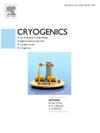Nusselt number correction for stacked wire mesh considering finite heat capacity below 50 K
IF 1.8
3区 工程技术
Q3 PHYSICS, APPLIED
引用次数: 0
Abstract
In regenerative cooling systems, the heat transfer characteristics of regenerators employing stacked wire mesh are critically important. Numerous experimental and numerical investigations have been conducted to characterize the Nusselt number of regenerators, focusing on room temperature conditions where the solid heat capacity is sufficiently large compared to that of the gas . In this study, the #400 stainless steel mesh is simulated in three dimensions at pore scale to investigate the Nusselt number across various flow conditions, considering both unidirectional and oscillating flow. Under unidirectional flow, the heat transfer characteristics below 77 K are studied. Considering the influence of finite heat capacity of stainless steel, a modified Nusselt number formula applicable to the 50 K to 20 K range is generalized. Subsequently, the heat transfer characteristics under oscillating flow, including different frequencies and pressure ratios, are investigated. The results provide further evidence supporting the similarity of Nusselt numbers between oscillating and unidirectional flow. This study provides a deeper insight into the heat transfer characteristics of wire mesh regenerators at low temperatures. Meanwhile, the forementioned modified coefficient can be used for better regenerator simulations.
考虑50 K以下有限热容量的叠丝网的努塞尔数校正
在蓄热式冷却系统中,蓄热器的传热特性至关重要。已经进行了大量的实验和数值研究来表征蓄热器的努塞尔数,重点是在室温条件下,固体热容量与气体热容量相比足够大。在本研究中,在孔隙尺度上对#400不锈钢网进行了三维模拟,研究了在考虑单向流动和振荡流动的情况下,不同流动条件下的努塞尔数。在单向流动条件下,研究了77k以下的换热特性。考虑到不锈钢有限热容的影响,推广了适用于50k ~ 20k范围的修正努塞尔数公式。在此基础上,研究了不同频率和压力比下的振荡流换热特性。结果进一步证明了振荡流和单向流之间努塞尔数的相似性。本研究对低温下金属丝网蓄热器的传热特性有了更深入的了解。同时,上述修正系数可用于更好的蓄热器模拟。
本文章由计算机程序翻译,如有差异,请以英文原文为准。
求助全文
约1分钟内获得全文
求助全文
来源期刊

Cryogenics
物理-热力学
CiteScore
3.80
自引率
9.50%
发文量
0
审稿时长
2.1 months
期刊介绍:
Cryogenics is the world''s leading journal focusing on all aspects of cryoengineering and cryogenics. Papers published in Cryogenics cover a wide variety of subjects in low temperature engineering and research. Among the areas covered are:
- Applications of superconductivity: magnets, electronics, devices
- Superconductors and their properties
- Properties of materials: metals, alloys, composites, polymers, insulations
- New applications of cryogenic technology to processes, devices, machinery
- Refrigeration and liquefaction technology
- Thermodynamics
- Fluid properties and fluid mechanics
- Heat transfer
- Thermometry and measurement science
- Cryogenics in medicine
- Cryoelectronics
 求助内容:
求助内容: 应助结果提醒方式:
应助结果提醒方式:


